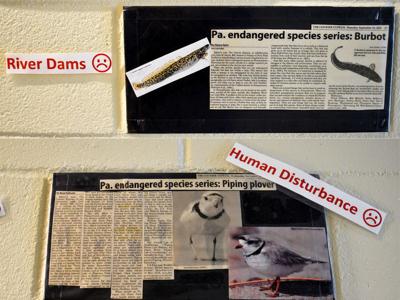Editor’s note: The Courier Express, in collaboration with Lola M. Smith, MS, lecturer in biology at Penn State DuBois, is republishing a series of work completed by college students about endangered species in Pennsylvania. This is an introduction to the series, which will appear once a week. References for the work, similar to a college research paper, are credited at the end for each article.
Endangered species are organisms that are very likely to become extinct in the near future. Most causes for endangerment are human induced. There are federal, state, local and private organizations that are concerned and have programs designed to monitor, keep tract of, and design programs to aid in the recovery of populations in peril. Based on the severity of their situation, organisms are given statuses such as endangered, threatened, vulnerable, rare or extirpated. These statuses can apply worldwide, by country, and by state. Recovery plans are designed with the intent of helping the organism’s population return to a healthy level.
Causes for endangerment include habitat loss and fragmentation, introduced species, overexploitation, pollution and other factors such as climate change and disease. Habitat loss and habitat fragmentation contribute most to endangerment. As the human population grows habitats are increasingly converted to cropland, urban development and homes. Habitats are chunked into smaller units by highways, housing development, forestry operations and dams. The impact on large organisms, who require large areas to survive and reproduce, is obvious. Not so obvious is the impact on small organisms like salamanders and frogs moving to find vernal pools in the spring. For these creatures even a rural, hot blacktop can be a huge barrier.
According to the International Union for Conservation of Nature (IUCN) there are more than 32,000 species worldwide threatened with extinction with 6,811 considered critically endangered (IUCN 2020). Amphibians are the largest group of endangered species with 41% of their known species endangered. This is followed by mammals (26%), conifers (34%), birds (14%), sharks and rays (30%), reef corals (33%) and selected crustaceans (28%) (IUCN 2020). The U.S. Fish and Wildlife Service’s (USFWS) Environmental Conservation Online System (ECOS) has 702 endangered and threatened animal species listed in their Species Report. This group includes amphibians, annelid worms, arachnids, birds, clams, corals, crustaceans, fishes, flatworms and roundworms, hydroids, insects, mammals, millipedes, reptiles, snails, and sponges. They have 934 threatened and endangered plants listed. This includes 890 flowering plants and 44 non-flowering plants (USFWS 2011).
The Pennsylvania Natural Heritage Program (PNHP) is a partnership between the Pennsylvania Department of Conservation and Natural Resources, the Pennsylvania Fish and Boat Commission, the Pennsylvania Game Commission, and the Western Pennsylvania Conservancy, and works in cooperation with the U.S. Fish and Wildlife Service. The PNHP lists 380 species as threatened or endangered in Pennsylvania. Of these 380 species 13 are listed as endangered and seven are listed as threatened by the U.S. Fish and Wildlife Service (PNHP 2019). Are you curious about how many are listed as endangered in your county? Go to the PNHP website in the “Resources” and then “Environmental Review Lists” tabs and choose your county from the dropdown list.
If an organism has federal endangered status the USFWS is responsible for establishing a recovery plan. Aside from granting the species federal protection, these plans may also incorporate the services of federal, state, and local agencies, tribal governments, conservation organizations, business communities, landowners, and other concerned citizens. The National oceanic and Atmospheric Administration has organisms such as sea turtles and marine mammals under their jurisdiction. The goal of the recovery plan is to remove the organism from the endangered species list. The plans are developed with attention to the specific needs of the organism. Surveys and monitoring of the species’ population may lead to decisions to acquire or restore habitat, remove invasive species, or release breeding pairs that have been raised in captivity. According to their 2019 Annual Report, the Association of Zoos and Aquariums Saving Animals From Extinction (SAFE) program spent $231,000,000 on field conservation. Recovery plans work. The USFWS (2011) states that “Since 1969, 99 percent of listed species have been prevented from going extinct through the efforts of the FWS Recovery program and our many partners”.
Penn State DuBois students in the Populations and Communities ecology course are providing information on species that are listed as endangered by the Commonwealth of Pennsylvania to raise awareness for locally endangered species. Their report and a picture of the organism they chose will be displayed, along with those of previous semesters, on a wall display titled “Terms of Endangerment” in the Swift Building on campus.
References
IUCN 2020. The IUCN Red List of Threatened Species. Version 2020-2. https://www.iucnredlist.org. Downloaded on 09 July 2020.
The Pennsylvania Natural Heritage Program. 2019. Environmental Review List. http://www.naturalheritage.state.pa.us . Retrieval date Oct 20, 2020
U. S. Fish and Wildlife Service. June 2011. Endangered Species Recovery Program 4401 N. Fairfax Drive, Room 420 Arlington, VA 22203703-358-2171 http://www.fws.gov/endangered/what-we-do/recovery-overview.htm Retrieval date: October 20, 2020.
U.S. Fish and Wildlife Service Environmental Conservation Online System https://ecos.fws.gov Retrieval date: October 18, 2020.


















